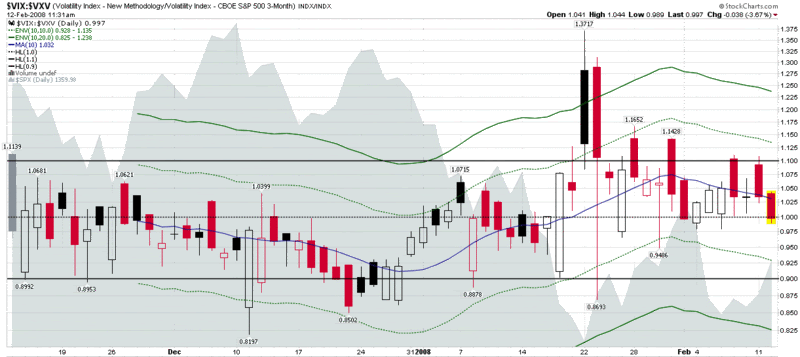The VIX, VXV and Volatility Expectations
I am frequently asked to provide more commentary on VIX futures and the extent to which expectations for future volatility as indicated by VIX futures contrasts sharply with the cash or spot VIX. While I think this is a worthwhile exercise, I am not a big fan of the various charts that I can easily put my hands on, including this one from FutureSource.com (which can be easily edited) that compares the August 2008 VIX futures with the cash VIX. The FutureSouce.com chart in the link above, for instance, uses different Y-axis values for the futures and the cash market, making comparisons a little too murky for my taste.
It is for these reasons that I was so excited when the CBOE announced the VXV, which is analogous to the VIX except that it uses a 93 day time horizon in lieu of the 30 day time frame of the VIX. Better yet, the VXV is supported by my favorite chart service, StockCharts.com, which makes it easy to provide a wide range of customizable comparisons of the VIX and the VXV.
Launched three months ago, the VXV chart finally has a critical mass of data that makes it easier to identify trends. My interest, however, is not so much the VXV in a vacuum as it is compared to the VIX. Hence the VIX:VXV ratio, which is what the chart below captures. While it is still relatively early to have high confidence trading rules for this ratio, my working hypothesis continues to be that this ratio will be mean reverting around 1.00, with the best long entries (for the SPX or other long instruments) when the ratio drops below 0.90 and the best short entries when the ratio rises above 1.10.
In addition to the extreme values that the VIX:VXV ratio generates as trading signals, some of the middling values may also have interpretive value. As I type this, for instance, the ratio sits at 0.997, suggesting that there is no discernable difference between volatility expectations over the next 30 days and over a 93 day period. Said another way, today’s rally does not seem to have put the VIX in an ‘oversold’ mode, at least relative to future volatility expectations.



5 comments:
Thank you for bringing up the VXV again, Bill... I'd forgotten about it since you last posted about it.
I agree that the standard FutureSource.com chart for two variables is not as useful as it could be, since it doesn't offer a %-change option on the y-axes that would allow the variables to be compared more easily.
They do offer a custom micro-chart option that you can use to chart spreads. The spread between the VIX Aug futures and the cash VIX could be displayed as:
http://futuresource.quote.com/charts/micro.jsp?s=%3D%27VX+7%21-cf%27+-+%27%24VIX%27&s=&s=&s=&s=&s=&s=&s=&p=D&v=15&b=BAR&d=HIGH
Similar spread charts can be created by editing the above URL directly, or by constructing them here:
http://futuresource.quote.com/charts/micro.jsp
Note that more complicated expressions comparing different futures and indexes can also be created (though the syntax is a bit confusing), and that multiple micro-charts can be displayed on the same page. Another cool thing is that you can get a full-sized chart of the spread by clicking on the micro-chart.
I'd be careful about using the VXV:VIX ratio as a market timing indicator without much more data, over a variety of market conditinos. While I agree with the general idea that the VIX should tend to be more volatile during market corrections than the further out VXV (which tends to be 'stickier'), in a massive market sell-off, SPX options market-makers will reach out for anything and everything, including the back months, to hedge the front-month puts they'd be selling to the buying public. That action would tend to make the IVs of the back-month options, and hence the VXV rise, perhaps almost as quickly as the VIX.
That said, a large IV inversion in the major indices (that is, when the front-month options have markedly higher implied volatilities than back-month options) generally suggests to me that a 'local' bottom is being formed, though a prolonged inversion (such as the one we've had this year) tends to make me nervous, because it suggests a sentiment shift towards near-term fear and bearishness.
IF the VIX futures three months out are well-correlated to the VXV, it may be worthwhile to investigate the ratio of those futures to the cash VIX as a temporary proxy for the VXV:VIX ratio (to test your hypotheses).
Thanks again for bringing up the VXV again.... I'll start including in my trading toolkit.
Best regards,
Felix aka thenakedtrader
Sorry to add to my previous over-long comment... can't believe I forgot to include it.
One problem I have with the cash VIX and VXV is that sometimes the CBOE (I think) is slow to post morning prices. Yesterday, it was almost ten a.m. (EST) before any cash VIX quotes were available.
This may have been due to the gap up in the SPX creating a situation in which more time was needed to get good quotes across the entire options chain, but twenty-five min. seems a little extreme.
otoh, VIX options started trading a few min. after the market open, based on values from the futures market (which correctly anticipated the gap down on the cash VIX).
tnt
Hi Felix,
Many thanks for the FutureSource tips. I like that spread chart a great deal and didn't realize you could generate charts along those lines from their site.
Now please excuse me while I go play around there a little more... :)
Cheers,
-Bill
My pleasure, Bill. I've found your blog so interesting and useful, as well as a great source of links to trading resources, that it's only fair that I try to give a little back. :)
tnt
Nice discovery. For delta-neutral options traders, this could be an excellent tool for knowing when to open short vega positions (e.g., iron condors) versus long vega strategies (e.g., double-diagonals).
Post a Comment